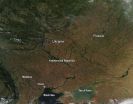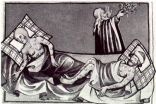(Press-News.org) PULLMAN, Wash. - Washington State University researchers have developed a unique method to use microbes buried in pond sediment to power waste cleanup in rural areas.
The first microbe-powered, self-sustaining wastewater treatment system could lead to an inexpensive and quick way to clean up waste from large farming operations and rural sewage treatment plants while reducing pollution.
Professor Haluk Beyenal and graduate student Timothy Ewing in the Voiland College of Engineering and Architecture discuss the system in the online edition of Journal of Power Sources and have filed for a patent.
Cutting greenhouse gases
Traditionally, waste from dairy farms in rural areas is placed in a series of ponds to be eaten by bacteria, generating carbon dioxide and methane pollution, until the waste is safely treated. In urban areas with larger infrastructure, electrically powered aerators mix water in the ponds, allowing for the waste to be cleaned faster and with fewer harmful emissions.
As much as 5 percent of energy used in the U.S. goes for waste water treatment, said Beyenal. Most rural communities and farmers, meanwhile, can't afford the cleaner, electrically powered aerators.
Microbial fuel cells use biological reactions from microbes in water to create electricity. The WSU researchers developed a microbial fuel cell that does the work of the aerator, using only the power of microbes in the sewage lagoons to generate electricity.
The researchers created favorable conditions for growth of microbes that are able to naturally generate electrons as part of their metabolic processes. The microbes were able to successfully power aerators in the lab for more than a year, and the researchers are hoping to test a full-scale pilot for eventual commercialization.
Hope for dairies
The researchers believe that the microbial fuel cell technology is on the cusp of providing useful power solutions for communities.
"Everyone is looking to improve dairies to keep them in business and to keep these family businesses going,'' said Ewing.
The technology could also be used in underdeveloped countries to more effectively clean polluted water: "This is the first step towards sustainable wastewater treatment,'' Ewing said.
Beyenal has been conducting research for several years on microbial fuel cells for low-power electronic devices, particularly for use in remote areas or underwater where using batteries is challenging. Last year, he and his graduate students used the microbes to power lights for a holiday tree.
Ewing, who grew up on a cattle ranch in Custer, Wash., developed an interest in microbial fuel cells as an undergraduate at WSU.
INFORMATION: END
Researchers develop unique waste cleanup for rural areas
Microbe-powered treatment cuts costs, reduces methane emissions
2014-09-18
ELSE PRESS RELEASES FROM THIS DATE:
Video games could dramatically streamline educational research
2014-09-18
PULLMAN, Wash. – "Seeking educational curriculum researchers. Humans need not apply."
A Washington State University professor has figured out a dramatically easier and more cost-effective way to do research on science curriculum in the classroom – and it could include playing video games.
Called "computational modeling," it involves a computer "learning" student behavior and then "thinking" as students would. Rich Lamb, who teaches science education at WSU's College of Education, said the process could revolutionize the way educational research is done.
Lamb's research ...
Tree rings and arroyos
2014-09-18
Boulder, Colo., USA – A new GSA Bulletin study uses tree rings to document arroyo evolution along the lower Rio Puerco and Chaco Wash in northern New Mexico, USA. By determining burial dates in tree rings from salt cedar and willow, investigators were able to precisely date arroyo sedimentary beds 30 cm thick or greater. They then combined this data with aerial imagery, LiDAR, longitudinal profiles, and repeat surveys to reconstruct the history of these arroyos.
Arroyos are deep, oversized channels that have vertical or steeply cut walls made up of silt, clay, or sand. ...
Spouse's personality influences career success, study finds
2014-09-18
As people spend more and more time in the workplace, it's natural for co-workers to develop close bonds — what's often referred to as a "workplace spouse" or an "office wife."
But when it comes to pay raises, promotions and other measures of career success, it's the husband or wife at home who may be exerting a bigger influence on workplace performance, suggests new research from Washington University in St. Louis. "Our study shows that it is not only your own personality that influences the experiences that lead to greater occupational success, but that your spouse's ...
Marcellus drilling boom may have led to too many hotel rooms
2014-09-18
Drilling in Pennsylvania's Marcellus Shale region led to a rapid increase in both the number of hotels and hotel industry jobs, but Penn State researchers report that the faltering occupancy rate may signal that there are now too many hotel rooms.
"Demand is still high in many of the counties in the Marcellus Shale region, but the occupancy rate is starting to come down," said Daniel Mount, an associate professor in hospitality management. "The case could be made that this is a sign that hotels were overbuilt."
Marcellus drilling operations generated approximately $685 ...
Survey: Fortune 500 employees can expect to pay more for health insurance
2014-09-18
Employees working for Fortune 500 companies can expect to pay higher employee contributions for their health insurance, according to a survey of chief human resource officers about the impact of the Patient Protection and Affordable Care Act (also known as PPACA or Obamacare) conducted by the Darla Moore School of Business at the University of South Carolina this past May/June.
Patrick Wright, a professor in strategic human resource management, directs the annual the HR@Moore Survey of Chief HR Officers. The survey is distributed to more than 560 CHROs of Fortune 500 ...
Agricultural fires in the Ukraine
2014-09-18
Numerous fires (marked with red dots) are burning in Eastern Europe, likely as a result of regional agricultural practices. The body of water at the lower left of this true-color Moderate Resolution Imaging Spectroradiometer (MODIS) image is the Sea of Azov. The Sea is bordered by Ukraine to the northwest, west and southwest and by Russia to the northeast, east, and southeast. To its left is the Black Sea.
The location, widespread nature, and number of fires suggest that these fires were deliberately set to manage land. Farmers often use fire to return nutrients to the ...
Professional recommendations against routine prostate cancer screening have little effect
2014-09-18
DETROIT – The effect of guidelines recommending that elderly men should not be routinely screened for prostate cancer "has been minimal at best," according to a new study led by researchers at Henry Ford Hospital.
The study, published as a research letter online in JAMA Internal Medicine, focused on the use of PSA – prostate-specific antigen – to test for prostate cancer.
"We found that the effect of the guidelines recommending against the routine screening of elderly men in particular has been minimal at best," says Jesse Sammon, D.O., a researcher at Henry Ford's Vattikuti ...
New insights on an ancient plague could improve treatments for infections
2014-09-18
DURHAM, N.C. – Dangerous new pathogens such as the Ebola virus invoke scary scenarios of deadly epidemics, but even ancient scourges such as the bubonic plague are still providing researchers with new insights on how the body responds to infections.
In a study published online Sept. 18, 2014, in the journal Immunity, researchers at Duke Medicine and Duke-NUS Graduate Medical School Singapore detail how the Yersinia pestis bacteria that cause bubonic plague hitchhike on immune cells in the lymph nodes and eventually ride into the lungs and the blood stream, where the infection ...
Sensing neuronal activity with light
2014-09-18
For years, neuroscientists have been trying to develop tools that would allow them to clearly view the brain's circuitry in action—from the first moment a neuron fires to the resulting behavior in a whole organism. To get this complete picture, neuroscientists are working to develop a range of new tools to study the brain. Researchers at Caltech have developed one such tool that provides a new way of mapping neural networks in a living organism.
The work—a collaboration between Viviana Gradinaru (BS '05), assistant professor of biology and biological engineering, and ...
No sedative necessary: Scientists discover new 'sleep node' in the brain
2014-09-18
BUFFALO, N.Y. – A sleep-promoting circuit located deep in the primitive brainstem has revealed how we fall into deep sleep. Discovered by researchers at Harvard School of Medicine and the University at Buffalo School of Medicine and Biomedical Sciences, this is only the second "sleep node" identified in the mammalian brain whose activity appears to be both necessary and sufficient to produce deep sleep.
Published online in August in Nature Neuroscience, the study demonstrates that fully half of all of the brain's sleep-promoting activity originates from the parafacial ...
LAST 30 PRESS RELEASES:
Making lighter work of calculating fluid and heat flow
Normalizing blood sugar can halve heart attack risk
Lowering blood sugar cuts heart attack risk in people with prediabetes
Study links genetic variants to risk of blinding eye disease in premature infants
Non-opioid ‘pain sponge’ therapy halts cartilage degeneration and relieves chronic pain
AI can pick up cultural values by mimicking how kids learn
China’s ecological redlines offer fast track to 30 x 30 global conservation goal
Invisible indoor threats: emerging household contaminants and their growing risks to human health
Adding antibody treatment to chemo boosts outcomes for children with rare cancer
Germline pathogenic variants among women without a history of breast cancer
Tanning beds triple melanoma risk, potentially causing broad DNA damage
Unique bond identified as key to viral infection speed
Indoor tanning makes youthful skin much older on a genetic level
Mouse model sheds new light on the causes and potential solutions to human GI problems linked to muscular dystrophy
The Journal of Nuclear Medicine ahead-of-print tip sheet: December 12, 2025
Smarter tools for peering into the microscopic world
Applications open for funding to conduct research in the Kinsey Institute archives
Global measure underestimates the severity of food insecurity
Child survivors of critical illness are missing out on timely follow up care
Risk-based vs annual breast cancer screening / the WISDOM randomized clinical trial
University of Toronto launches Electric Vehicle Innovation Ontario to accelerate advanced EV technologies and build Canada’s innovation advantage
Early relapse predicts poor outcomes in aggressive blood cancer
American College of Lifestyle Medicine applauds two CMS models aligned with lifestyle medicine practice and reimbursement
Clinical trial finds cannabis use not a barrier to quitting nicotine vaping
Supplemental nutrition assistance program policies and food insecurity
Switching immune cells to “night mode” could limit damage after a heart attack, study suggests
URI-based Global RIghts Project report spotlights continued troubling trends in worldwide inhumane treatment
Neutrophils are less aggressive at night, explaining why nighttime heart attacks cause less damage than daytime events
Menopausal hormone therapy may not pose breast cancer risk for women with BRCA mutations
Mobile health tool may improve quality of life for adolescent and young adult breast cancer survivors
[Press-News.org] Researchers develop unique waste cleanup for rural areasMicrobe-powered treatment cuts costs, reduces methane emissions







